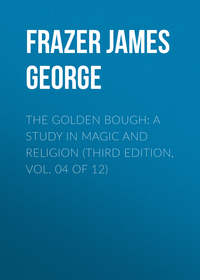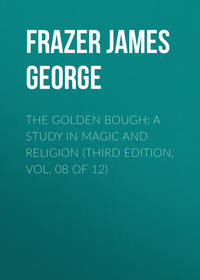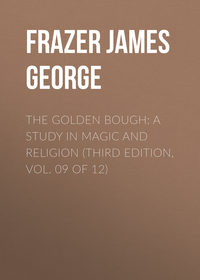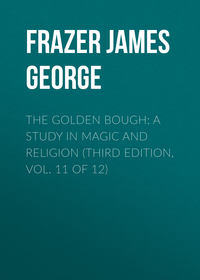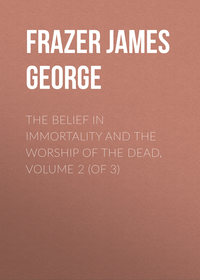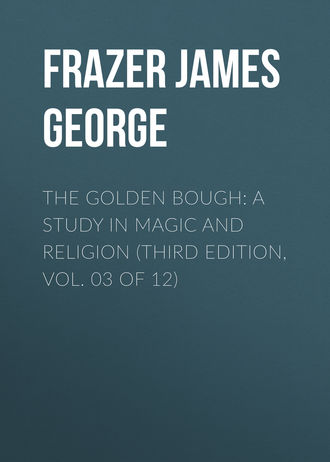 полная версия
полная версияThe Golden Bough: A Study in Magic and Religion (Third Edition, Vol. 03 of 12)
338
E. R. Smith, The Araucanians (London, 1855), p. 222.
339
Rev. A. Hetherwick, “Some Animistic Beliefs among the Yaos of British Central Africa,” Journal of the Anthropological Institute, xxxii. (1902) pp. 89 sq.
340
W. A. Elmslie, Among the Wild Ngoni (Edinburgh and London, 1899), pp. 70 sq.
341
J. Thomson, Through Masai Land (London, 1885), p. 86.
342
E. Clodd, in Folk-lore, vi. (1895) pp. 73 sq., referring to The Times of March 24, 1891.
343
L. A. Waddell, Among the Himalayas (Westminster, 1899), pp. 85 sq.
344
E. Young, The Kingdom of the Yellow Robe (Westminster, 1898), p. 140.
345
Ch. Dallet, Histoire de l'Église de Corée (Paris, 1874), i. p. xxv. This account of Corea was written at a time when the country was still almost secluded from European influence. The events of recent years have naturally wrought great changes in the habits and ideas of the people.
346
“Iets over het bijgeloof in de Minahasa,” Tijdschrift voor Nederlandsch Indië, III. Série, iv. (1870) pp. 8 sq.
347
J. Freiherr von Brenner, Besuch bei den Kannibalen Sumatras (Würzburg, 1894), p. 195.
348
A. W. Nieuwenhuis, Quer durch Borneo, i. 314.
349
“A Far-off Greek Island,” Blackwood's Magazine, February 1886, p. 235.
350
J. A. E. Köhler, Volksbrauch, Aberglauben, Sagen und andre alte Überlieferungen im Voigtlande (Leipsic, 1867), p. 423.
351
W. R. S. Ralston, Songs of the Russian People, p. 117.
352
Miss M. E. Durham, High Albania (London, 1909), p. 107.
353
F. H. Groome, In Gipsy Tents (Edinburgh, 1880), pp. 337 sq.
354
James Napier, Folk-lore, or Superstitious Beliefs in the West of Scotland, p. 142. For more examples of the same sort, see R. Andree, Ethnographische Parallelen und Vergleiche, Neue Folge (Leipsic, 1889), pp. 18 sqq.
355
Menander Protector, in Fragmenta historicorum Graecorum, ed. C. Müller, iv. 227. Compare Gibbon, Decline and Fall of the Roman Empire, ch. xlii. vol. vii. pp. 294 sq. (Edinburgh, 1811).
356
G. Turner, Samoa, pp. 291 sq.
357
Charles New, Life, Wanderings, and Labours in Eastern Africa (London, 1873), p. 432. Compare ibid. pp. 400, 402. For the demons on Mt. Kilimanjaro, see also J. L. Krapf, Travels, Researches, and Missionary Labours in Eastern Africa (London, 1860), p. 192.
358
Pierre Bouche, La Côte des Esclaves et le Dahomey (Paris, 1885), p. 133.
359
A. van Gennep, Tabou et totémisme à Madagascar (Paris, 1904), p. 42.
360
C. A. L. M. Schwaner, Borneo (Amsterdam, 1853-54), ii. 77.
361
Ibid. ii. 167.
362
A. W. Nieuwenhuis, Quer durch Borneo, ii. 102.
363
E. Aymonier, Notes sur le Laos (Saigon, 1885), p. 196.
364
Bulletin de la Société de Géographie (Paris), IVme Série, vi. (1853) pp. 134 sq.
365
H. von Rosenberg, Der malayische Archipel (Leipsic, 1878), p. 198.
366
D. W. Horst, “Rapport van eene reis naar de Noordkust van Nieuw Guinea,” Tijdschrift voor Indische Taal- Land- en Volkenkunde, xxxii. (1889) p. 229.
367
Capt. John Moresby, Discoveries and Surveys in New Guinea (London, 1876), pp. 102 sq.
368
R. I. Dodge, Our Wild Indians (Hartford, Conn., 1886), p. 119.
369
J. Crevaux, Voyages dans l'Amérique du Sud (Paris, 1883), p. 300.
370
J. G. F. Riedel, De sluik- en kroesharige rassen tusschen Selebes en Papua, p. 78.
371
J. Kreemer, “Hoe de Javaan zijne zieken verzorgt,” Mededeelingen van wege het Nederlandsche Zendelinggenootschap, xxxvi. (1892) p. 13. Mr. E. W. Lewis, of Woodthorpe, Atkins Rood, Clapham Park, London, S.W., writes to me (July 2, 1902) that his grandmother, a native of Cheshire, used to make bees sting her as a cure for local rheumatism; she said the remedy was infallible and had been handed down to her from her mother.
372
Father Baudin, “Le Fétichisme,” Missions Catholiques, xvi. (1884) p. 249; A. B. Ellis, The Yoruba-speaking Peoples of the Slave Coast (London, 1894), pp. 113 sq.
373
A. Bastian, Allerlei aus Volks- und Menschenkunde (Berlin, 1888), i. 116.
374
J. B. de Callone, “Iets over de geneeswijze en ziekten der Daijakers ter Zuid Oostkust van Borneo,” Tijdschrift voor Neêrlands Indie, 1840, dl. i. p. 418.
375
M. T. H. Perelaer, Ethnographische Beschrijving der Dajaks, pp. 44, 54, 252; B. F. Matthes, Bijdragen tot de Ethnologie van Zuid-Celebes (The Hague, 1875), p. 49.
376
H. Grützner, “Über die Gebräuche der Basutho,” in Verhandlungen der Berliner Gesellschaft für Anthropologie, Ethnologie, und Urgeschichte, 1877, pp. 84 sq.
377
L. Decle, Three Years in Savage Africa (London, 1898), p. 81.
378
P. Reichard, Deutsch-Ostafrika (Leipsic, 1892), p. 431.
379
Nieuwenhuisen en Rosenberg, “Verslag omtrent het eiland Nias,” in Verhandelingen van het Bataviaasch Genootschap van Kunsten en Wetenschappen, xxx. (Batavia, 1863) p. 26.
380
R. Parkinson, “Zur Ethnographie der Ontong Java- und Tasman-Inseln,” Internationales Archiv für Ethnographie, x. (1897) p. 112.
381
T. S. Weir, “Note on Sacrifices in India as a Means of averting Epidemics,” Journal of the Anthropological Society of Bombay, i. 35.
382
E. O'Donovan, The Merv Oasis (London, 1882), ii. 58.
383
Emin Pasha in Central Africa, being a Collection of his Letters and Journals (London, 1888), p. 107.
384
H. Ling Roth, Great Benin (Halifax, England, 1903), p. 123.
385
Narrative of the Second Arctic Expedition made by Charles F. Hall, edited by Prof. J. G. Nourse, U.S.N. (Washington, 1879), p. 269, note. Compare Fr. Boas, “The Central Eskimo,” Sixth Annual Report of the Bureau of Ethnology (Washington, 1888), p. 609.
386
J. A. Grant, A Walk across Africa, pp. 104 sq.
387
E. Shortland, Traditions and Superstitions of the New Zealanders2 (London, 1856), p. 103.
388
N. von Miklucho-Maclay, “Ethnologische Bemerkungen über die Papuas der Maclay-Kuste in Neu-Guinea,” Natuurkundig Tijdschrift voor Nederlandsch Indie, xxxvi. 317 sq.
389
Fr. Stuhlmann, Mit Emin Pascha ins Herz von Afrika (Berlin, 1894), p. 94.
390
R. Brough Smyth, Aborigines of Victoria, i. 134.
391
A. W. Howitt, Native Tribes of South-East Australia, p. 403.
392
Ch. Hose, Notes on the Natives of British Borneo (in manuscript).
393
A. C. Kruijt, “Het koppensnellen der Toradja's van Midden-Celebes, en zijne beteekenis,” Verslagen en Mededeelingen der Konikl. Akademie van Wetenschappen, Afdeeling Letterkunde, iv. Reeks, iii. (1899) p. 204.
394
Scholiast on Euripides, Phoenissae, 1377, ed. E. Schwartz.
395
Conon, Narrationes, 18; Pausanias, iii. 19. 12; Francis Fleming, Southern Africa (London, 1856), p. 259; Dudley Kidd, The Essential Kafir, p. 307.
396
See The Magic Art and the Evolution of Kings, vol. ii. pp. 263 sq.
397
John Campbell, Travels in South Africa, being a Narrative of a Second Journey in the Interior of that Country (London, 1822), ii. 205.
398
Ladislaus Magyar, Reisen in Süd-Afrika (Buda-Pesth and Leipsic, 1859), p. 203.
399
Fr. Stuhlmann, Mit Emin Pascha ins Herz von Afrika (Berlin, 1894), p. 89.
400
J. Roscoe, “Further Notes on the Manners and Customs of the Baganda,” Journal of the Anthropological Institute, xxxii. (1902) p. 62.
401
C. J. Andersson, Lake Ngami2 (London, 1856), p. 223.
402
Washington Matthews, “The Mountain Chant: a Navajo Ceremony,” Fifth Annual Report of the Bureau of Ethnology (Washington, 1887), p. 410.
403
Asiatick Researches, vi. 535 sq. ed. 4to (p. 537 sq. ed. 8vo).
404
François Valentyn, Oud en nieuw Oost-Indiën, iii. 16.
405
A. W. Nieuwenhuis, In Centraal Borneo, i. 165.
406
G. Turner, Samoa, pp. 305 sq.
407
De Plano Carpini, Historia Mongolorum quos nos Tartaros appellamus, ed. D'Avezac (Paris, 1838), cap. iii. § iii. p. 627, cap. ult. § i. x. p. 744, and Appendix, p. 775; “Travels of William de Rubriquis into Tartary and China,” in Pinkerton's Voyages and Travels, vii. 82 sq.
408
Paul Pogge, “Bericht über die Station Mukenge,” Mittheilungen der Afrikanischen Gesellschaft in Deutschland, iv. (1883-1885) pp. 182 sq.
409
Coillard, “Voyage au pays des Banyais et au Zambèse,” Bulletin de la Société de Géographie (Paris), VIme Série, xx. (1880) p. 393.
410
J. L. Krapf, Travels, Researches, and Missionary Labours during an Eighteen Years' Residence in Eastern Africa (London, 1860), pp. 252 sq.
411
O. Dapper, Description de l'Afrique (Amsterdam, 1686), p. 391.
412
Proyart, “History of Loango, Kakongo,” etc., in Pinkerton's Voyages and Travels, xvi. 583; Dapper, op. cit. p. 340; J. Ogilby, Africa (London, 1670), p. 521. Compare A. Bastian, Die deutsche Expedition an der Loango-Küste, i. 288.
413
A. Bastian, op. cit. i. 268 sq.
414
See above, pp. 8 sq.
415
L. von Ende, “Die Baduwis auf Java,” Mittheilungen der anthropologischen Gesellschaft in Wien, xix. (1889) pp. 7-10. As to the Baduwis (Badoejs) see also G. A. Wilken, Handleiding voor de vergelijkende Volkenkunde van Nederlandsch-Indië (Leyden, 1893), pp. 640-643.
416
A. B. Ellis, The Ewe-speaking Peoples of the Slave Coast, p. 107.
417
J. B. Neumann, “Het Pane- en Bila- Stroomgebied op het eiland Sumatra,” Tijdschrift van het Nederlandsch Aardrijkskundig Genootschap, Tweede Serie, dl. iii. (1886) Afdeeling, meer uitgebreide artikelen, No. 2, p. 300.
418
J. Richardson, “Tanala Customs, Superstitions and Beliefs,” The Antananarivo Annual and Madagascar Magazine, Reprint of the First Four Numbers (Antananarivo, 1885), p. 219.
419
W. Cornwallis Harris, The Highlands of Aethiopia, iii. 171 sq.
420
Th. Lefebvre, Voyage en Abyssinie, i. p. lxxii.
421
Lieut. V. L. Cameron, Across Africa (London, 1877), ii. 71; id., in Journal of the Anthropological Institute, vi. (1877) p. 173.
422
Ebn-el-Dyn el-Eghouâthy, “Relation d'un voyage dans l'intérieur de l'Afrique septentrionale,” Bulletin de la Société de Géographie (Paris), IIme Série, i. (1834) p. 290.
423
J. Teit, “The Thompson Indians of British Columbia,” Memoir of the American Museum of Natural History, The Jesup North Pacific Expedition, vol. i. part iv. (April 1900) p. 360.
424
Th. Williams, Fiji and the Fijians.2 i. 249.
425
“Adventures of Andrew Battel,” in Pinkerton's Voyages and Travels, xvi. 330; O. Dapper, Description de l'Afrique, p. 330; A. Bastian, Die deutsche Expedition an der Loango-Küste, i. 262 sq.; R. F. Burton, Abeokuta and the Cameroons Mountains, i. 147.
426
Proyart's “History of Loango, Kakongo,” etc., in Pinkerton's Voyages and Travels, xvi. 584.
427
J. L. Wilson, Western Africa, p. 202; John Duncan, Travels in Western Africa, i. 222. Compare W. W. Reade, Savage Africa, p. 543.
428
Paul Pogge, Im Reiche des Muata Jamwo (Berlin, 1880), p. 231.
429
F. T. Valdez, Six Years of a Traveller's Life in Western Africa (London, 1861), ii. 256.
430
A. F. Mockler-Ferryman, Up the Niger (London, 1892), p. 38.
431
Baron Roger, “Notice sur le gouvernement, les mœurs et les superstitions des Nègres du pays de Walo,” Bulletin de la Société de Géographie (Paris), viii. (1827) p. 351.
432
G. Schweinfurth, The Heart of Africa, ii. 45 (third edition, London, 1878); G. Casati, Ten Years in Equatoria (London and New York, 1891), i. 177. As to the various customs observed by Monbutto chiefs in drinking see G. Burrows, The Land of the Pigmies (London, 1898), pp. 88, 91.
433
J. G. Frazer, Totemism and Exogamy, ii. 526, from information furnished by the Rev. John Roscoe.
434
W. Cornwallis Harris, The Highlands of Aethiopia, iii. 78.
435
A. B. Ellis, The Ewe-speaking Peoples of the Slave Coast, pp. 162 sq.
436
Capt. James Cook, Voyages, v. 374 (ed. 1809).
437
Heraclides Cumanus, in Athenaeus, iv. 26, p. 145 b-d. On the other hand, in Kafa no one, not even the king, may eat except in the presence of a legal witness. A slave is appointed to witness the king's meals, and his office is esteemed honourable. See F. G. Massaja, in Bulletin de la Société de Géographie (Paris), Vme Série, i. (1861) pp. 330 sq.; Ph. Paulitschke, Ethnographie Nordost-Afrikas: die geistige Cultur der Danâkil, Galla und Somâl (Berlin, 1896), pp. 248 sq.
438
Notes analytiques sur les collections ethnographiques du Musée du Congo, I. Les Arts, Religion (Brussels, 1902-1906), p. 164.
439
Mohammed Ibn-Omar el Tounsy, Voyage au Darfour (Paris, 1845), p. 203; Travels of an Arab Merchant [Mohammed Ibn-Omar el Tounsy] in Soudan, abridged from the French (of Perron) by Bayle St. John (London, 1854), pp. 91 sq.
440
Mohammed Ibn-Omar el Tounsy, Voyage au Ouadây (Paris, 1851), p. 375.
441
Ibn Batoutah, Voyages, ed. C. Defrémery et B. R. Sanguinetti (Paris, 1853-1858), iv. 441.
442
Le Commandant Mattei, Bas-Niger, Bénoué, Dahomey (Paris, 1895), pp. 90 sq.
443
H. Ternaux-Compans, Essai sur l'ancien Cundinamarca, p. 60.
444
Manuscrit Ramirez, histoire de l'origine des Indiens qui habitent la Nouvelle Espagne selon leurs traditions, publié par D. Charnay (Paris, 1903), pp. 107 sq.
445
Herodotus, i. 99.
446
A. B. Ellis, The Yoruba-speaking Peoples of the Slave Coast, p. 170.
447
Ebn-el-Dyn el-Eghouathy, “Relation d'un voyage,” Bulletin de la Société de Géographie (Paris), IIme Série, i. (1834) p. 290; H. Duveyrier, Exploration du Sahara: les Touareg du Nord, pp. 391 sq.; Reclus, Nouvelle Géographie Universelle, xi. 838 sq.; James Richardson, Travels in the Great Desert of Sahara, ii. 208.
448
J. Wellhausen, Reste arabischen Heidentums2 (Berlin, 1897), p. 196.
449
Tertullian, De virginibus velandis, 17 (Migne's Patrologia Latina, ii. col. 912).
450
Pseudo-Dicaearchus, Descriptio Graeciae, 18, in Geographi Graeci Minores, ed. C. Müller, i. 103; id., in Fragmenta Historicorum Graecorum, ed. C. Müller, ii. 259.
451
G. Turner, Samoa, pp. 67 sq.
452
J. G. F. Riedel, “Die Landschaft Dawan oder West-Timor,” Deutsche geographische Blätter, x. 230.
453
A. W. Howitt, “On some Australian Ceremonies of Initiation,” Journal of the Anthropological Institute, xiii. (1884) p. 456.
454
Above, pp. 30 sqq.
455
See above, pp. 5, 8 sq.
456
This rule was mentioned to me in conversation by Miss Mary H. Kingsley. However, he is said to have shewn himself outside his palace on solemn occasions once or twice a year. See O. Dapper, Description de l'Afrique, pp. 311 sq.; H. Ling Roth, Great Benin, p. 74. As to the worship of the king of Benin, see The Magic Art and the Evolution of Kings, vol. i. p. 396.
457
A. Bastian, Die deutsche Expedition an der Loango-Küste, i. 263. However, a case is recorded in which he marched out to war (ibid. i. 268 sq.).
458
S. Crowther and J. C. Taylor, The Gospel on the Banks of the Niger (London, 1859), p. 433.
459
Le Commandant Mattei, Bas-Niger, Bénoué, Dahomey (Paris, 1895), pp. 67-72. The annual dance of the king of Onitsha outside of his palace is mentioned also by S. Crowther and J. C. Taylor (op. cit. p. 379), and A. F. Mockler-Ferryman (Up the Niger, p. 22).
460
“Mission Voulet-Chanoine,” Bulletin de la Société de Géographie (Paris), VIIIme Série, xx. (1899) p. 223.
461
C. Partridge, Cross River Natives (London, 1905), p. 7; compare id. pp. 8, 200, 202, 203 sq. See also Major A. G. Leonard, The Lower Niger and its Tribes (London, 1906), pp. 371 sq.
462
Strabo, xvii. 2. 2 σέβονται δ᾽ ὡς θεοὺς τουσ βασιλεασ, κατακλειστουσ οντασ και οἰκουροὺς τὸ πλέον.
463
Xenophon, Anabasis, v. 4. 26; Scymnus Chius, Orbis descriptio, 900 sqq. (Geographi Graeci Minores, ed. C. Müller, i. 234); Diodorus Siculus, xiv. 30. 6 sq.; Nicolaus Damascenus, quoted by Stobeaus, Florilegium, xliv. 41 (vol. ii. p. 185, ed. Meineke); Apollonius Rhodius, Argon. ii. 1026, sqq., with the note of the scholiast; Pomponius Mela, i. 106, p. 29, ed. Parthey. Die Chrysostom refers to the custom without mentioning the name of the people (Or. xiv. vol. i. p. 257, ed. L. Dindorf).
464
Strabo, xvi. 4. 19, p. 778; Diodorus Siculus, iii. 47. Inscriptions found in Sheba (the country about two hundred miles north of Aden) seem to shew that the land was at first ruled by a succession of priestly kings, who were afterwards followed by kings in the ordinary sense. The names of many of these priestly kings (makarribs, literally “blessers”) are preserved in inscriptions. See Prof. S. R. Driver, in Authority and Archaeology Sacred and Profane, edited by D. G. Hogarth (London, 1899), p. 82. Probably these “blessers” are the kings referred to by the Greek writers. We may suppose that the blessings they dispensed consisted in a proper regulation of the weather, abundance of the fruits of the earth, and so on.
465
Heraclides Cumanus, in Athenaeus, xii. 13, p. 517 b. c.
466
Ch. Dallet, Histoire de l'Église de Coreé (Paris, 1874), i. pp. xxiv-xxvi. The king sometimes, though rarely, left his palace. When he did so, notice was given beforehand to his people. All doors must be shut and each householder must kneel before his threshold with a broom and a dust-pan in his hand. All windows, especially the upper ones, must be sealed with slips of paper, lest some one should look down upon the king. See W. E. Griffis, Corea, the Hermit Nation, p. 222. These customs are now obsolete (G. N. Curzon, Problems of the Far East, Westminster, 1896, pp. 154 sq. note).
467
This I learned from the late Mr. W. Simpson, formerly artist of the Illustrated London News.
468
Richard, “History of Tonquin,” in Pinkerton's Voyages and Travels, ix. 746.
469
Shway Yoe, The Burman (London, 1882), i. 30 sq.; compare Indian Antiquary, xx. (1891) p. 49.
470
G. Taplin, “The Narrinyeri,” in Native Tribes of South Australia (Adelaide, 1879), pp. 24-26; id., in E. M. Curr, The Australian Race, ii. p. 247.
471
G. Taplin, “The Narrinyeri,” in Native Tribes of South Australia, p. 63; id., “Notes on the Mixed Races of Australia,” Journal of the Anthropological Institute, iv. (1875) p. 53; id., in E. M. Curr, The Australian Race, ii. 245.
472
H. E. A. Meyer, “Manners and Customs of the Aborigines of the Encounter Bay Tribe,” in Native Tribes of South Australia, p. 196.




